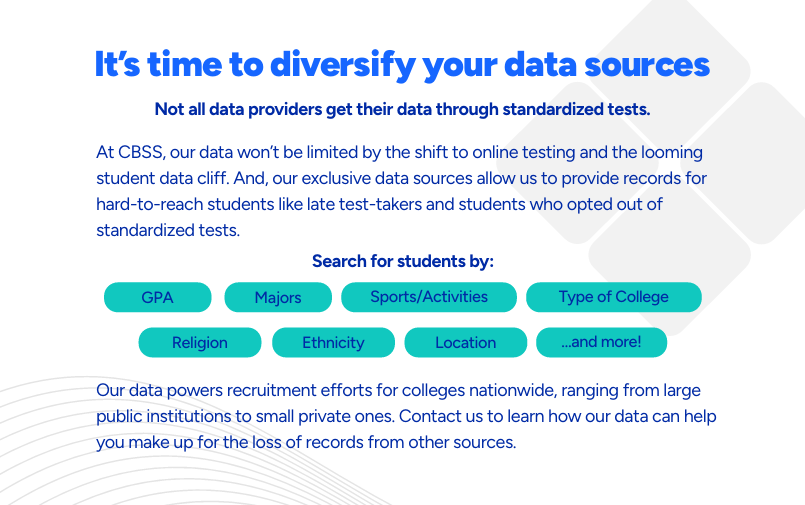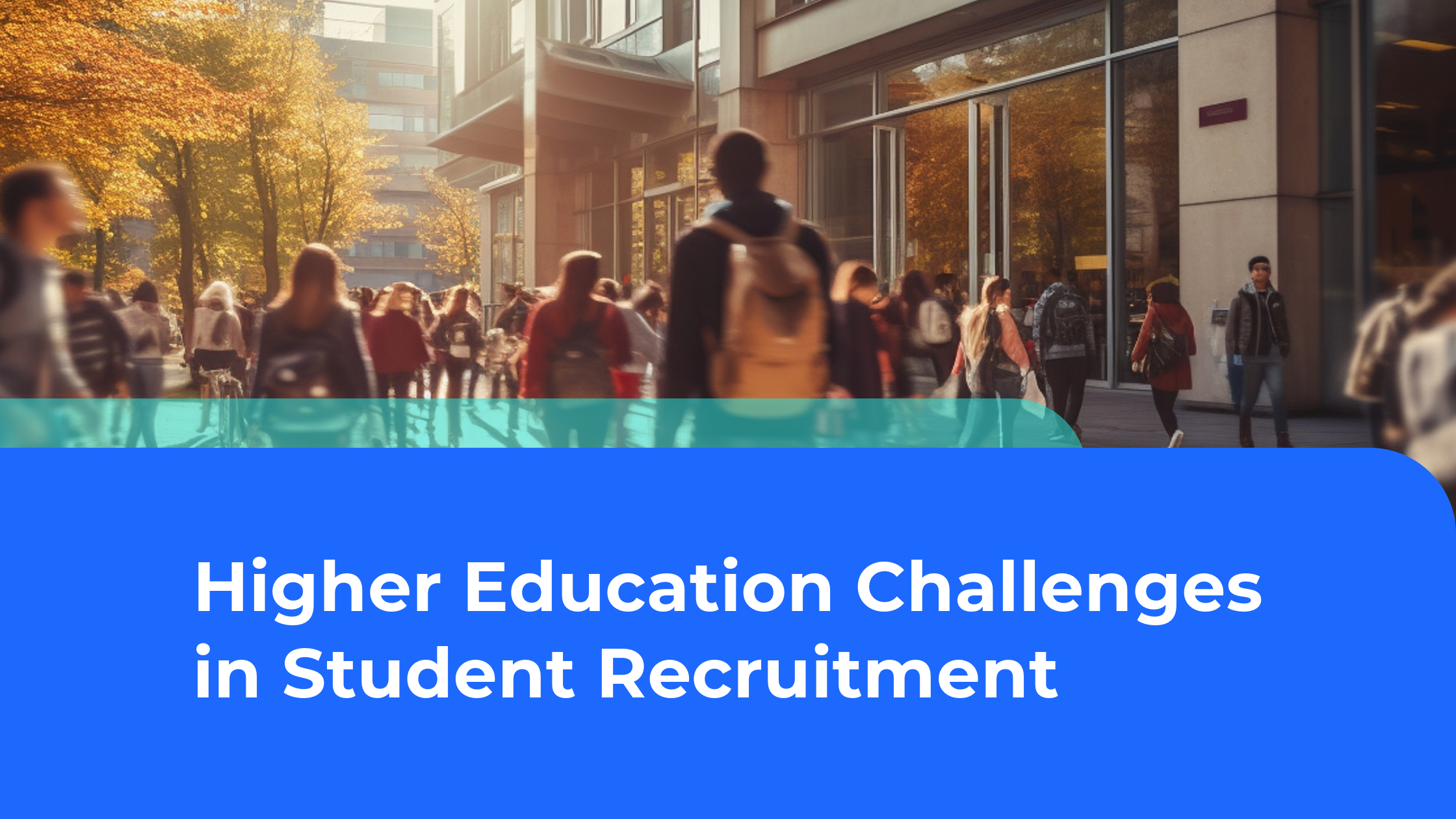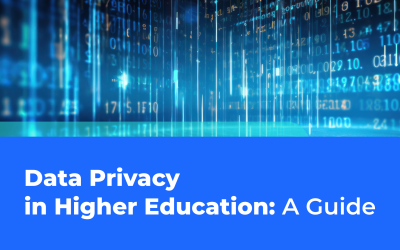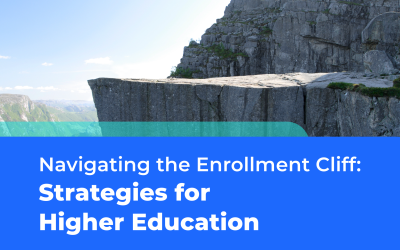Colleges across the U.S. are experiencing major challenges with their recruitment strategy; traditional methods of acquiring high school student data are rapidly changing. In the past, many colleges typically relied on standardized test providers for their high school student data sources. However, there’s a projected drop of 40% in the number of student names that will be available for colleges to license.
The projected drop in available student names is due to the growing popularity of digital testing. However, other major challenges will further restrict student recruitment.
New privacy restrictions, the shift to digital standardized testing, changes in how colleges can search for high school graduates, and more challenges are causing colleges to rethink their enrollment strategies.
It’s important to understand the changes happening with search, digital testing, and other challenges impacting college recruitment. This guide will explain these challenges and how your college can navigate them.
Changes and Challenges for the Higher Education Sector
There are several issues that colleges are facing, including the search cliff. Below are the enrollment changes and challenges that colleges need to be aware of:
The Search Cliff Explained
The “Search Cliff” is the decline in student names available for colleges to search for recruitment purposes. Online standardized testing and privacy restrictions are the contributing factors that have created the search cliff.
In 2023, the number of names available to colleges was over 2.2 million. By 2026, colleges should expect a decline of 32% in the number of student names available. As a result, higher education institutions must find alternative data sources to make up for the declining access to student names.
The Shift to Digital Testing
Historically, students have taken standardized tests in person. When students would take these tests, they could opt-in to make their information available to college admissions offices. Students would then receive various marketing materials from colleges, scholarship opportunities, and more.
With the shift to digital testing, many states have online privacy restrictions—preventing sources from providing digital test-takers’ data to colleges. Colleges that depend on these data sources are expected to see a 40% decline in access to student records.
The shift to digital testing is the main cause of the search cliff. Recruitment strategies for colleges will need to evolve as colleges find alternative sources for student records.
Is the Search Cliff Different from the Demographic Cliff?
Yes, the search cliff is different than the demographic cliff, but they are both contributing to the overall challenge colleges are facing with less student data available for their recruitment efforts.
With the search cliff, there will be fewer student names available to colleges because of digital testing and online privacy restrictions. The demographic cliff, also called the enrollment cliff, is the overall decline in the population of high school graduates due to factors like declining birth rates from the Great Recession and students opting for a different path after high school.
Privacy Restrictions
In the last couple of years, privacy restrictions have increased surrounding student information and many states have adopted legislation. Below are some common regulations across the United States:
- California adopted SOPIPA in 2014. This act prohibited education technology service providers from selling student data they gather to third parties. Many other states have created their own legislation that is similar to SOPIPA.
- FERPA is an act that is used in all U.S. states. It protects student education records and provides parents with access rights.
- New York has legislation that protects students’ data called Education Law 2-d.
These are just some of the laws and legislation that restrict colleges’ ability to connect with prospective students.
The Rise of Test-Optional Policies
Over 2,000 colleges and universities have adopted test-optional or test-free policies in their admissions programs. While test-optional is a nice incentive for students to apply to your college, it’s also contributing to the decline in the number of students available. If a college has a test-optional policy, then students may plan ahead and not take a standardized test if they want to apply for that college.
In recent years, there has been much conversation about standardized testing becoming obsolete. While the SAT and ACT are not going away—at least not anytime soon—it is important to understand how this would impact the number of records available for recruitment purposes.
The changes happening to standardized testing are contributing to the decline in the availability of student names. Because of these factors, sources that get student data from test providers are experiencing a large drop in available names; so, colleges have less data for their recruitment efforts.
A More Competitive Recruiting Situation
With the decrease in student records available, the recruitment landscape will become a more competitive environment for colleges. Many colleges may be getting their records from the same sources—meaning that they’re trying to recruit the same students. It’s more important than ever to ensure your college stands out among competitors, which you can do by diversifying your data sources and obtaining unique data that comparable colleges don’t have access to.
Email Deliverability Issues
Many colleges are facing email deliverability issues that are impacting their recruitment efforts. Whether marketing emails are ending up in students’ spam folders, bouncing, or facing setbacks with new requirements for bulk email senders—these factors are making it harder for colleges to reach students via email.
Higher Ed Marketing Trends to Help with the Search Cliff
While there are many challenges for college recruitment right now, there are still other ways to connect with students and tools to help navigate the enrollment cliff. Here are some higher ed recruitment trends:
Optimize Your Recruitment with a Personalized Marketing Outreach Strategy
Every high school student is different—and having different calls to action for your marketing outreach can help you connect with more students. Segmenting your audiences and providing personalized messaging provides students with a more meaningful interaction with your college.
Connect with More Students by Expanding Your Digital Advertising and Social Media Efforts
While you may not be able to acquire student information from standardized test sources, you can still reach your target audience of students through your social media efforts and paid ads. With many high school students spending time daily on social media, this channel is still a great way to connect and reach students.
Predict Your College’s Search Cliff Impact
Over the next 3 years, the amount of names available will drop, and colleges will need to find new recruitment data. By being proactive and seeing how your college will be affected, you can evolve your recruitment strategy to keep up with the search cliff changes.
To prepare for the search cliff, check out this Search Cliff Calculator from CollegeVine! See how your state will be impacted by the search cliff so your college can adapt its recruitment efforts.
Navigate Your College Recruitment Challenges with CBSS
As standardized tests move to digital formats, the number of student records will drop by nearly 40%. Losing 40% of your leads would be a critical blow to your enrollment, but it doesn’t have to be! Evolving your college recruitment strategy and finding new data sources can help fill your college’s enrollment gaps.
Diversify your recruiting sources with CBSS. We hold over a third of the unique student recruitment records in the industry. And, we’re the only data supplier that allows comprehensive deduplication against all sources, which helps identify and deliver the students you may have missed from your specific target groups and areas.
Next Steps for Your College’s Recruitment Efforts
Searching for students is changing for college recruitment, which means your strategies for enrollment also need to change. To help your college navigate the search cliff, you need to have accurate student data. Contact CBSS today and ask us how we can help you with these recruitment challenges.

Learn More about Current Higher Education Challenges
- CBSS offers a variety of student data—whether you want to target high school students or unique learners like adults, we can help! Learn more about our student data.
- Expand your recruitment efforts and market to adult learners. Learn why adult learners are a valuable audience to recruit in this blog post.
- The Chronicle of Higher Education covers a variety of topics about what is happening in higher education. Check out their articles to keep up-to-date with higher education trends and challenges.




